
* In the late 1960s, Japan began to consider development of a tandem-seat supersonic jet trainer that could be adapted as a single-seat strike aircraft. Using the Anglo-French SEPECAT Jaguar trainer / strike aircraft as a model, Mitsubishi developed the "T-2" jet trainer and "F-1" strike aircraft. The T-2 and F-1 were the first supersonic aircraft to be developed in Japan, and gave several decades of reliable service. In the 1980s, the T-2 was complemented by a subsonic trainer, the Kawasaki "T-4". This document gives a history and description of the T-2 / F-1 and T-4.
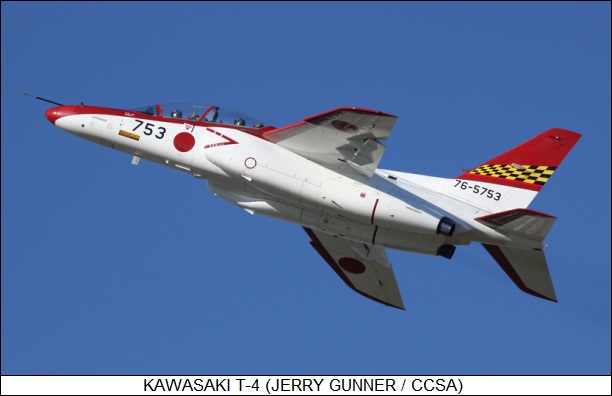
* In the mid-1960s, the Japanese Air Self-Defense Force (JASDF) began to search about for a new jet trainer, tentatively designated the "T-X". There was a belief that the modern Mach 2 fighters then being acquired and operated by the JASDF -- including the Lockheed F-104J Starfighter and, eventually, the McDonnell F-4EJ Phantom -- required a supersonic advanced trainer. The T-X was also seen as the basis for a single-seat strike aircraft, tentatively designated the "SF-X".
Supersonic jet trainers were something of a fad at the time. The US Air Force had already acquired the Northrop T-38 Talon supersonic trainer, and the Anglo-French SEPECAT Jaguar partly emerged from a perceived need for a supersonic trainer, though it would effectively end up being used as a strike fighter. Both the T-38 and the two-seat Jaguar were promoted by their respective nations as solutions to the Japanese training requirement, while the Northrop F-5, a complementary design to the T-38, and the single-seat Jaguar were promoted for the strike requirement. The JASDF was very interested in the Jaguar and the Japanese even negotiated to build it under license, but royalty issues and nationalism led the Japanese to decide to build their own design.
Fuji, Kawasaki, and Mitsubishi submitted proposals in early 1967, with the Mitsubishi design selected as the winner on 5 September 1967, with a formal contract issued for development of the "XT-2" on 30 March 1968. The design team was led by Dr. Ikeda Kenji, chief engineer of Mitsubishi. Fuji was to be a major subcontractor, and several other Japanese aviation firms obtained substantial subcontracts as well, ensuring that all the major Japanese aerospace firms got their slice of the government pie.
A preliminary mockup was unveiled on 24 April 1968, and by the spring of 1969 the design had been finalized. The initial XT-2 prototype performed its first flight on 20 July 1971, with Endo Kenshiro and Sato Mitsui in the cockpit. It was followed by three more prototypes, for a total of four. It became the first aircraft of Japanese design to break Mach 1 in level flight.
The type entered JASDF service in 1975. 90 production T-2s were built, including 28 unarmed "T-2(Z)s", with the "Z" standing for "Zenkigata (early type)" and 62 armed "T-2(K)s", with the "K" standing for "Kokigata (late type)"; some sources translate these variants as "T-2A" and "T-2B" respectively. Two of the four prototypes were unarmed, two were armed. An additional two T-2(Z)s were built but modified for the S-FX / F-1 strike fighter program off the production line, as discussed below. The last T-2 was delivered in 1988.
* Given that the Japanese requirements for the T-FX weren't so different from those that gave rise to the Jaguar, it wasn't too surprising that Mitsubishi engineers saw the Jaguar as something of a model for what they wanted to do. The T-2's configuration was clearly reminiscent of that of the two-seat Jaguar, with the two aircraft having the same overall configuration and some resemblance in details. In particular, the T-2 was also powered by two Rolls-Royce / Turbomeca Adour afterburning low-bypass turbofan jets, the same powerplants used by the Jaguar, with the engines license-built by Ishikawajima-Harima Heavy Industries under the designation "TF40-IHI-801A".
However, the T-2 was also clearly not a copy of the Jaguar. The best way to describe the Jaguar's role in the T-2's design was as "inspirational". The two aircraft could be distinguished at a glance, with the T-2 having a more dartlike appearance, being noticeably longer and having a distinctly shorter wingspan than the Jaguar. The Japanese machine also had many detail differences -- for example, since the JASDF had no rough-field requirement, the T-2 had conventional single-wheeled landing gear and not the distinctive "farm tractor" landing gear of the Jaguar.
The T-2 was made mostly of aircraft aluminum alloys, though it featured selective use of titanium. The high-mounted wings had a leading-edge sweep of 42.5 degrees and a 9 degree anhedral droop. The wings featured a noticeable "leading edge root extensions (LERXs)" and full span leading-edge flaps, with a "dogtooth" discontinuity on the outer edge of the span; the dogtooth did not split the flap. There was a single 3/4ths-span flap in the back, unlike the split full-span double slotted flaps of the Jaguar, but the T-2 did have twin spoilers on each wing just forward of the flap for roll control instead of ailerons, another element clearly derived from the Jaguar. There was a small fence mounted inboard on the top of the wing. There were no fuel tanks in the wings.
The tail assembly was conventional, featuring slab all-moving tailplanes with an anhedral droop of 15 degrees. The steep anhedral kept the tailplanes out of the engine exhaust, while allowing them to remain effective through the wing wash. Like the Jaguar, there was a fixed ventral fin under each exhaust, and a hydraulically-operated airbrake just forward of each ventral fin.
Each Adour engine provided 22.75A kN (2,320 kgp / 5,115 lbf) max dry thrust and 32.49 kgp (3,315 kgp / 7,305 lbf) afterburning thrust. The TF40-IHI-801As did not have the "part throttle reheat" feature added to Adour 102s as an engine-out safety feature, and the T-2 was never refitted with more powerful Adour engine variants, along the lines of the Adour 104 eventually refitted to British Jaguars, leaving the T-2 somewhat underpowered. The engine intakes had fixed rectangular geometry and fuselage splitter plates, plus a set of spring-loaded auxiliary inlets behind the intake lip for increased airflow in ground running. There were large service doors beneath the fuselage that provided easy access to the engines for maintenance.
The T-2's landing gear all featured single wheels, with the nose gear retracting backward and the main gear retracting forward into the fuselage, rotating 90 degrees to lie flat, another scheme that echoed the Jaguar. The nose gear was offset slightly to the right, with a small fixed vertical airfoil mounted in front of it to compensate for the extended nose gear's tendency to cause yaw. The landing gear featured an anti-skid control system. Also like the Jaguar, the T-2 had a runway arresting hook, in this case on the underside of the tail behind the engine exhausts, and a drag chute in the tailcone.
The aircrew sat in tandem, with the flight instructor sitting behind the cadet on a raised seat to give a good forward view. There was a windblast screen between the two cockpits, and of course there were dual controls. The aircrew sat under separate clamshell canopies on Weber ES-7J zero-zero (zero altitude, zero speed) ejection seats, built by Daiseru. The seats featured specially fitted canopy penetrators to ensure safe ejection even if the canopy wasn't blown off. The seats also dispensed a cloud of radar-reflecting "chaff" on ejection to allow ground controllers to spot where the ejection occurred, and then direct search and rescue teams to the proper area.
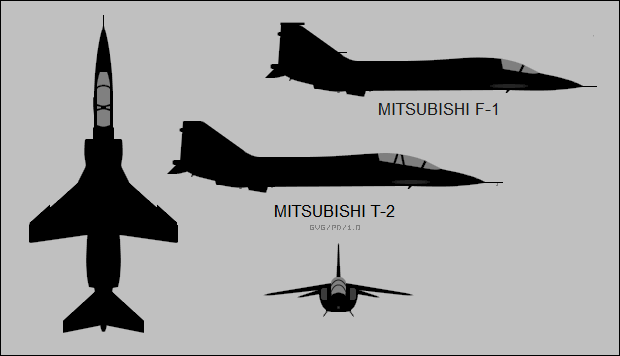
Standard equipment for the armed T-2(K) included a Mitsubishi Electric J/AWG-11 search and ranging radar in the nose; a French Thomson-CSF head-up display (HUD), license-built by Mitsubishi Electric; a Lear-Siegler 501OBL automatic heading and reference system (AHRS); as well as a UHF radio, an identification friend or foe (IFF) system, and a TACAN radio beacon navigation receiver system, all built in Japan. The J/AWG-11 was basically a member of the family of radars fitted to the US F-4 Phantom, in specific being very similar to the AN/AWG-11 fitted to the British Royal Navy Phantom FG.1. The unarmed T-2(Z) lacked the radar, though apparently its avionics kit was otherwise the same as that of the T-2(K).
___________________________________________________________________
MITSUBISHI T-2:
___________________________________________________________________
wingspan:
7.88 meters (25 feet 10 inches)
wing area:
21.17 sq_meters (227.88 sq_feet)
length:
17.86 meters (58 feet 7 inches)
height:
4.39 meters (14 feet 5 inches)
empty weight:
6,307 kilograms (13,905 pounds)
MTO weight:
12,800 kilograms (28,219 pounds)
max speed at altitude:
1,700 KPH (1,055 MPH / 920 KT)
service ceiling:
15,240 meters (50,000 feet)
ferry range:
2,595 kilometers (1,610 MI / 1,400 NMI)
___________________________________________________________________
The T-2(K) featured built-in armament, consisting of a General Electric M61 Vulcan 20-millimeter six-barreled Gatling-type cannon, license-built in Japan as the JM61 and mounted on the left side of the fuselage, under the cockpit. The nose gear's offset, mentioned above, was to accommodate the cannon. The ammunition store was behind the rear cockpit. Of course, this weapon was not fitted to the T-2(Z). All T-2s had four underwing hardpoints, the inner two being "wet", and the aircraft could be fitted with wingtip launch rails for Sidewinder air-to-air missiles (AAM).
The T-2 could carry a respectable, if not impressive, external load of up to 2,000 kilograms (4,400 pounds), including up to two 821-liter (217 US gallon) external tanks. Apparently pylons were usually only fitted for carriage of external tanks, and it is unlikely that the wingtip launch rails were often fitted to the unarmed T-2(Z).
* In service, the T-2 was painted standard training colors of overall light grey, with the unarmed T-2(Z)s distinguished by dayglo orange on the nose, LERXs, and the tips of the flight surfaces. A few T-2(K)s were provided to operational units flying the F-1 strike fighter, presumably for operational conversion, with these T-2s featuring a light green / dark green / tan camouflage pattern, as used on the F-1.

A number of T-2s, peaking at eight machines, were also used in the "aggressor" role, being painted in color schemes to simulate possible opponents, such as overall silver with a black-painted nose and other black patterns to make them resemble the MiG-21. They were eventually replaced in the aggressor role with the F-15DJ, whose superior performance made it a better aggressor. Apparently the safety record of the T-2 also played a part in their replacement; the type was said to have nasty spin characteristics, though little information on the T-2's handling has appeared in print.
Six T-2(K)s were used by the JASDF "Blue Impulse" flight demonstration team, with the aircraft painted in spiffy dark blue / light blue / white colors, fitted with a multi-color smoke generator, and flown in formation aerobatics to wow the crowds. The first performances of the Blue Impulse with the T-2 were flown in 1982. The Blue Impulse team traded in their T-2s for new Kawasaki T-4s in 1995.
One T-2 was used as an experimental platform by the Japan Defense Agency (JDA), modified as the "T-2 Control Configured Vehicle (T-2CCV)". The aircraft was fitted with a fin under the nose, moving canard fins on the engine inlets, and a triple-redundant digital fly-by-wire system; the back seat was loaded up with test avionics. The T-2CCV performed its first flight on 9 August 1983, and performed a set of 138 test flights in 1984 through 1986. It was painted in spiffy red-white-black colors, with a red-on-white lightning bolt along the fuselage and "CCV" in big letters on the tail.
BACK_TO_TOP* As mentioned, the Japanese had planned to develop a single-seat strike fighter version of the T-2 under the SF-X program. A formal development contract for the "F-1" strike fighter was issued in 1973, and, also as mentioned, two T-2s were taken from the production line to be converted into prototypes. These two machines were originally given the designation of "Special Spec T-2", then "T-2(FS)", and then "FS-T2 Kai", where "Kai" was short for "kaizen (modification)". The initial conversion performed its maiden flight on 3 June 1975. The type was ordered into production after a year's evaluation at the JASDF test center at Gifu, with the production F-1 performing its initial flight on 16 June 1977.
The F-1 was basically much like the armed T-2(K), with identical dimensions and almost identical performance -- the only major visual difference being that the T-2's rear cockpit was faired over and used as an avionics bay, with an access cover that hinged open to the left. The rules of the development program specified that minimal changes were to be made to the T-2 airframe to get the aircraft into service more quickly and at lower cost. The F-1 featured the TF40-IHI-801 engines; the built-in JM61 Vulcan cannon; and the four wing hardpoints and wingtip launch rails for Sidewinder AAMs. However, unlike the T-2, the F-1 had a centerline pylon, which was "wet" to allow carriage of another external tank, permitting the main underwing stores pylons to be used to carry munitions.
The F-1's avionics kit was a superset of the T-2's. It differed in fit of a J/AWG-12 radar, instead of the J/AWG-11 of the T-2(K), with the J/AWG-12 similar to the AN/AWG-12 fitted to the British Royal Air Force Phantom FGR.2. The radar was backed up by a Mitsubishi Electric J/ASQ-1 fire control system (FCS); and the Lear-Siegler AHRS was augmented by a J/ASN-1 inertial navigation system, a license-built copy of the Ferranti 6TNJ-F unit. The F-1 also featured a J/APR-3 radar homing and warning system (RHAWS), with a tubular antenna at the top of the tailfin, as well as a J/APN-44 radar altimeter system, a J/A24G-3 air data computer, and a strike camera system.
The F-1's primary role was anti-ship strike, with normal configuration including carriage of two drop tanks, two ASM-1 anti-shipping missiles, and (if needed) two AIM-9L Sidewinder AAMs, one on each wingtip launch rail, for self-defense. The ASM-1 was a solid-fuel missile with an active radar seeker. The Japanese are very sensitive about the defensive nature of their armed forces, and the ASM-1 was formally described as an "anti-landing craft" missile -- though of course, it could be used against almost any floating target. The F-1 was cued to targets for the ASM-1 by other platforms, such as Japanese Maritime Self-Defense Force Lockheed P-3C Orions, since the J/AWG-12 radar had limited range.
The F-1 could also carry 70-millimeter and 125-millimeter unguided rocket pods, as well as "iron" bombs and cluster bombs, with a maximum external load of up to 2,720 kilograms (6,000 pounds). Apparently the F-1 could also carry infrared-guided bombs -- an interesting Japanese munition that looks very much like a laser-guided bomb, but is designed to autonomously home in on maritime targets from heat signature.
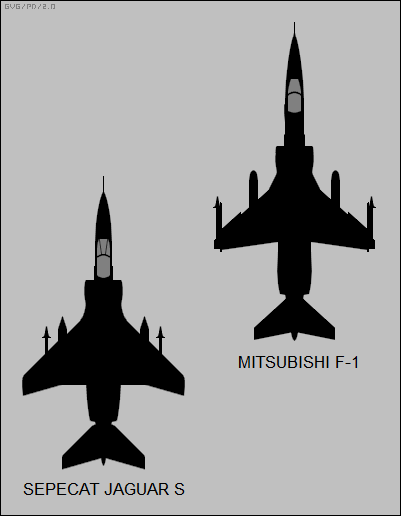
* The F-1 entered operational service with the JASDF in April 1978. A total of 160 was planned, but budget cuts meant that only 77 production machines were actually built, with the last delivered in March 1987. There was talk of an "RT-2" reconnaissance variant of the F-1, but the JASDF settled on the RF-4EJ Phantom instead. The standard color scheme for the F-1 was light green / dark green / tan disruptive camouflage, similar to standard USAF camouflage used over Vietnam, but with somewhat different color shades. Various other color schemes, such as a two-tone sea gray camouflage for maritime operations, were also evaluated, but not formally adopted.
The F-1 fleet was upgraded with an improved J/AWG-12 radar beginning in 1982, and in the mid-1990s the ASM-1 missile gave way to its much improved ASM-2 derivative, featuring turbojet propulsion to provide longer range and fitted with a much smarter imaging infrared (IIR) seeker system. A service-life extension program (SLEP) was also begun in the mid-1990s, with the effort increasing the F-1's airframe life from 3,500 to 4,000 hours. The Japanese fielded an improved Sidewinder follow-on of local design, the "AAM-3", but the elderly F-1 was not qualified to carry it. The F-1 was an attractive aircraft and proved serviceable, certainly superior to the JASDF combat aircraft it replaced, but foreign observers commented that in terms of published warload, performance, and range figures, it was not particularly impressive.
Both the T-2 and the F-1 were finally phased out of service in 2006. The F-1 was replaced by the much more formidable Mitsubishi F-2A, an advanced derivative of the Lockheed Martin F-16, developed in Japan. Delays in the F-2 program led to the F-1 SLEP effort. Ironically, the F-2 program turned out to be a classic Japanese-style defense program -- resulting in a much more expensive weapon than could have been bought elsewhere, and production was cut short.
The T-2 was replaced in the advanced training role by the Kawasaki T-4, and in the conversion training role by the F-15DJ and the F-2B, the two-seat versions of the F-15J and F-2A respectively. Neither the T-2 nor the F-1 ever fired a shot in anger, and that probably suits the Japanese just fine.
BACK_TO_TOP* The Mitsubishi T-2 trainer had not really been intended to perform the intermediate flight training role for the JASDF, which continued to be handled through the 1970s by the venerable Lockheed T-33 and the Fuji T-1 -- a subsonic tandem-seat aircraft modeled on the F-86 Sabre. By the late 1970s, both the T-33 and T-1 were clearly elderly and in need of a replacement, and the Japan Defense Agency requested designs from Fuji and Kawasaki for a new subsonic trainer.
In 1981, the JDA selected the Kawasaki "KA-851" design, produced by an engineering team under Isozaki Kouki, over the Fuji "FT-20", leading to a contract for two nonflying static-test airframes and four flying prototypes. As with the T-2, subcontracts were distributed over the pool of major Japanese aerospace firms. Detail design was complete by the end of 1983 and prototype construction began in the spring of 1984, leading to first flight of the initial "XT-4" prototype on 29 July 1985. The first production "T-4" was delivered to the JASDF in 1988.
* As introduced, the T-4 was a conservative design, with such a configurational resemblance to the Dassault-Dornier Alpha Jet that it is hard to believe Kawasaki engineers didn't see the Alpha Jet as a model for what they wanted to do. However, even if that was the case, as with the T-2 and the Jaguar the influence was only inspirational -- the T-4 was by no means a copy of the Alpha Jet, and the two machines could be told apart at a glance. The T-4 had a muscular, masculine appearance, while the Alpha Jet was more wasplike and feminine; the T-4 was bigger in length and span, and had an empty weight about 10% greater.
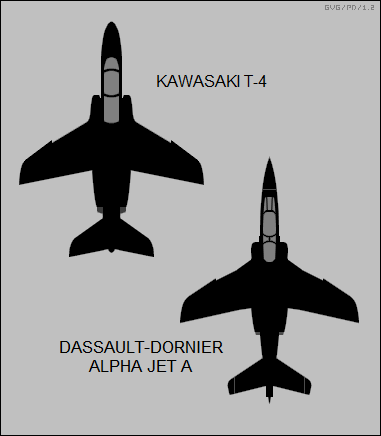
The T-4 was mostly made of aircraft aluminum alloys, with some control surfaces made of carbon-fiber / epoxy composite, plus very selective use of titanium. It had high-mounted swept wings, with a supercritical airfoil section and a leading-edge dogtooth; a conventional swept tail assembly; tricycle landing gear; twin engines, one mounted in a pod along each side of the fuselage; and a tandem-seat cockpit with dual controls.
The wings had a sweep of 27.5 degrees, an anhedral droop of 7 degrees, and featured ailerons for roll control and double slotted flaps. The tailplanes were all-moving, and also had an anhedral droop of 7 degrees. There was an airbrake on each side of the rear fuselage. Flight controls were hydraulic, while hydraulic systems were dual redundant.
The landing gear assemblies all featured single wheels and all retracted forward, with the main gear retracting into the fuselage. The landing gear featured an anti-skid braking system. The twin engines were Ishikawajima-Harima F3-IHI-30 low-bypass turbofan jets, of Japanese design, with a maximum take-off thrust of 16.28 kN (1,660 kgp / 3,660 lbf).
The instructor and cadet both sat on UPCO / Stencel SIIS-3 zero-zero ejection seats, with the instructor's seat in the rear raised 27 centimeters (10.6 inches) to give a good forward view. The cockpit was pressurized, with a one-piece canopy that provided excellent visibility and hinged open to the right. The cockpit layout was analog but featured a Kaiser HUD. Standard avionics included a VHF/UHF radio; a TACAN beacon navigation system; VOR / ILS landing aids; a ring-laser gyro AHRS; and video and flight-data recorders.
___________________________________________________________________
KAWASAKI T-4:
___________________________________________________________________
wingspan:
9.94 meters (32 feet 7.5 inches)
wing area:
21.0 sq_meters (226.05 sq_feet)
length:
13.0 meters (42 feet 8 inches)
height:
4.60 meters (15 feet 1.35 inches)
empty weight:
3,790 kilograms (8,536 pounds)
MTO weight:
7,500 kilograms (16,534 pounds)
max speed at sea level:
1,040 KPH (645 MPH / 560 KT)
service ceiling:
15,240 meters (50,000 feet)
range (internal fuel):
1,300 kilometers (805 MI / 700 NMI)
___________________________________________________________________
The T-4 could be fitted with a stores pylon under each wing and under the fuselage centerline, for a total of three pylons. The wing pylons were wet and could be used to carry 450-liter (119 US gallon) external tanks. Other external stores included a centerline target winch for the target tug role; an air-sampling pod for detection of fallout or other atmospheric pollutants; jammer or chaff pods for electronic warfare training; and a baggage pod for use in the liaison role. The aircraft also included a baggage compartment in the center fuselage.
The T-4 did not have a built-in cannon, but it could in principle carry a centerline cannon pod or other weapons and munitions, allowing it to be used for weapons training. It is unclear if it ever was qualified for weapons carriage.
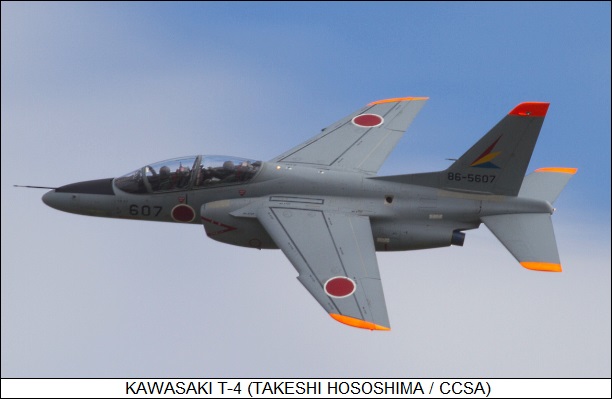
* The T-4 earned a reputation as strong, agile, and pleasant to fly, while being cheap to operate. T-4s serving in the training role were typically painted overall gray with dayglo orange on the tips of the flight surfaces, though decorative paint jobs did show up on occasion. Some of the few given to operational squadrons, for keeping up flight hours and for use as hacks, have apparently been painted in camouflage colors to match the combat aircraft they share the flight line with.
As mentioned, the Blue Impulse team re-equipped with the T-4 in 1995, with their six machines painted in spiffy blue-and-white colors and fitted with a smoke generator system. The Blue Impulse T-4s also had a stronger canopy, presumably to deal with bird strikes and other low-level hazards; a ground-proximity warning system; and a few other modifications for their aerobatic display role. While not as fast as the T-2, the T-4 proved much more agile and much less expensive to fly. Unfortunately, two of the Blue Impulse T-4s hit a mountain during low-visibility conditions on 4 July 2000, with three aircrew killed. The team performed with only four aircraft through 2001 and into 2002, though they were back up to six by the beginning of 2003.
A total of 208 production T-4s was built. The JASDF has no further requirement for new T-4s at present. There was talk of upgrading the machine, but at last notice the JASDF was thinking more in terms of a replacement.
BACK_TO_TOP* I originally wanted to write up the T-2 / F-1 as part of a document on the Jaguar, since the two types have something of a familial relationship, but the Jaguar writeup turned out to be surprisingly complicated, and I would have had to split it into two parts to add the T-2 / F-1. It made as much sense to just build two separate documents. Having done that, I decided to add the Kawasaki T-4, since I was interested in it and couldn't think of any better place to put a writeup on that aircraft. As usual, I ended up doing about twice as much work as I planned. I'm obsessive. I admit it.

* While traditionally, English-language documents given Japanese names in the Western form of personal name first, family name second, it is becoming more the practice of listing them in Japanese form -- family name first, personal name second. The Chinese have now established this naming order as a norm, so it might as well be applied to the Japanese as well.
* Sources include:
* Revision history:
v1.0.0 / 01 sep 03
v1.0.1 / 01 sep 05 / Review & polish.
v1.0.2 / 01 aug 07 / Review & polish.
v1.0.3 / 01 jul 09 / Cleanup, T-2 / F-1 obsolescence.
v1.0.4 / 01 jun 11 / Review & polish.
v1.0.5 / 01 apr 13 / Review & polish.
v1.0.6 / 01 mar 15 / Review & polish.
v1.0.7 / 01 feb 17 / Review & polish.
v1.0.8 / 01 jan 19 / Review & polish.
v1.0.9 / 01 dec 20 / Review & polish.
v1.1.0 / 01 oct 22 / Review & polish.
v1.1.1 / 01 jul 24 / Review & polish.
BACK_TO_TOP
